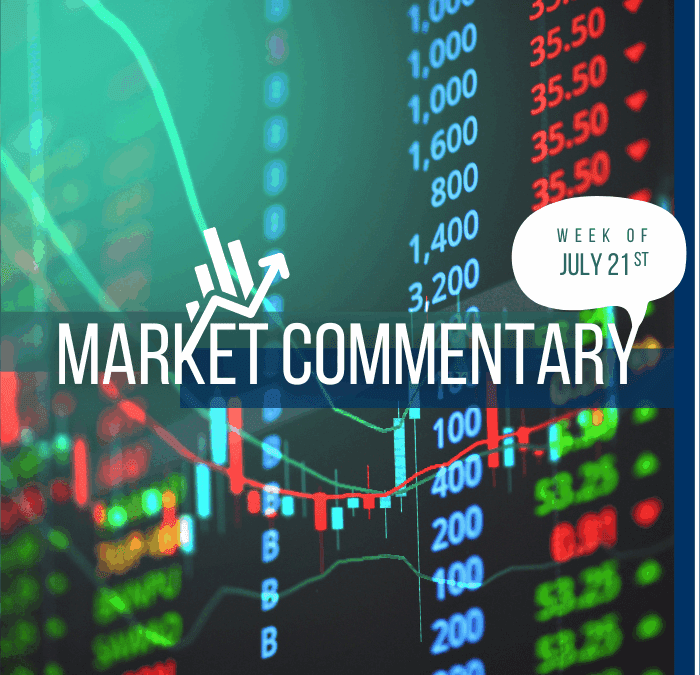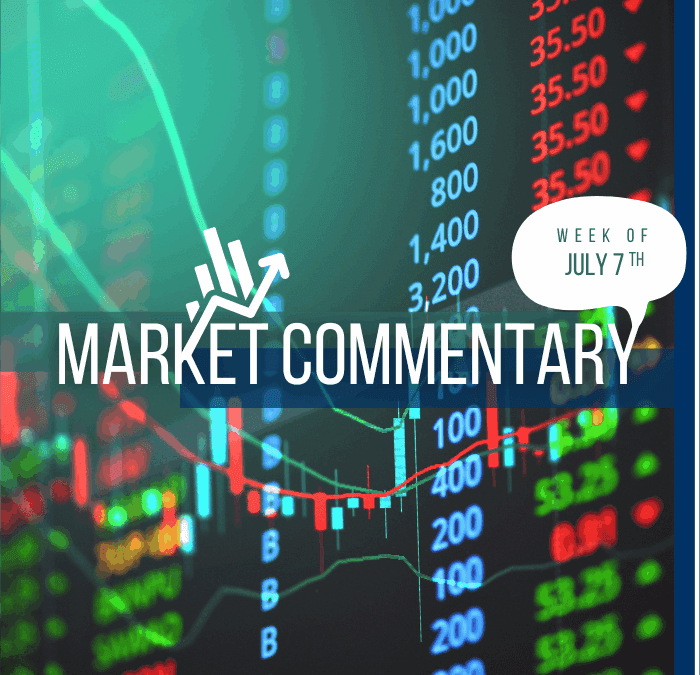
Market Commentary | August 4th, 2025
Weekly Market Commentary
August 4th, 2025
Week in Review…
Markets closed the week on a turbulent note as investors digested a series of revised labor market reports and inflation data that painted a mixed picture of the U.S. economy.
Labor Market: Signs of Softening Amid Conflicting Signals
The week began with the Job Openings and Labor Turnover Survey (JOLTS) showing a modest decline in June, down 0.2% from May, suggesting a slight cooling in labor demand. However, Wednesday’s ADP Nonfarm Employment Change surprised to the upside, posting a gain of 104,000 jobs versus expectations of 77,000. This broke a three-month streak of weak reports and reversed the prior month’s loss of 23,000 jobs.
Despite ADP’s strength, Friday’s Bureau of Labor Statistics Nonfarm Payrolls report told a different story. Payrolls rose by just 73,000, well below the 106,000 expected. More striking were the sharp downward revisions to previous months: May’s job gains were slashed from 144,000 to just 19,000, and June’s from 147,000 to 14,000. The unemployment rate ticked up to 4.2%, while average hourly earnings rose modestly, both in line with forecasts.
Inflation: Mixed Signals but Lower Expectations
Inflation data offered a more subdued counterpoint to the labor market volatility. The Core Personal Consumption Expenditures (PCE) Price Index rose 0.3% month-over-month, slightly above the prior reading but within expectations. The University of Michigan’s July inflation expectations showed a small increase in 1-year forecasts and a dip in 5-year projections, reflecting a broader trend of easing inflation concerns.
Other Economic Highlights
Q2 GDP growth came in at 3.0%, a sharp rebound from last quarter’s -0.5% and well above expectations. Sentiment indicators were mixed: S&P Global and the Institute for Supply Management (ISM) pointed to softening manufacturing outlooks, while the Conference Board’s Consumer Confidence Index came in stronger than expected.
Week Ahead…

With markets still recalibrating after last week’s labor market shock, the week ahead offers a quieter but still meaningful slate of data that could shape expectations around growth, inflation, and Fed policy.
Services Sector in Focus
On Tuesday, both S&P Global and ISM will release Services Purchasing Managers’ Index (PMI) reports. Expectations point to continued expansion in the services sector, but markets will be watching closely for signs of weakness. Given the sector’s outsized role in the U.S. economy, these reports offer valuable insight into overall economic health. In light of last week’s disappointing jobs data and sharp revisions, analysts may pay particular attention to the ISM Non-Manufacturing Employment component to see if sentiment reflects labor market softness.
Labor Market Efficiency and Cost Metrics
On Thursday, the spotlight shifts to Nonfarm Productivity (quarter-over-quarter) and Unit Labor Costs (quarter-over-quarter). These secondary labor indicators provide deeper context: rising productivity can support wage growth without fueling inflation, while higher unit labor costs may signal future inflationary pressures.
Other Reports to Watch
- Factory Orders (month-over-month): A direct gauge of manufacturing momentum, with implications for demand, capex, and supply chains.
- 10- and 30-Year Bond Auctions: Key for assessing demand for U.S. long-term debt and market expectations for inflation, the 10-year is especially relevant to mortgage rates.
- Consumer Credit: Offers a snapshot of consumer borrowing and confidence. However, this report is often subject to large revisions and should be interpreted cautiously.
With macro signals still in flux, the coming weeks may offer more clarity or introduce new complexities worth watching.
Economic Indicators:
- CPI: Consumer Price Index measures the average change in prices paid by consumers for goods and services over time. Source: Bureau of Labor Statistics.
- Core CPI: Core Consumer Price Index excludes food and energy prices to provide a clearer picture of long-term inflation trends. Source: Bureau of Labor Statistics.
- PPI: Producer Price Index measures the average change in selling prices received by domestic producers for their output. Source: Bureau of Labor Statistics.
- Core PPI: Core Producer Price Index excludes food and energy prices to provide a clearer picture of long-term inflation trends. Source: Bureau of Labor Statistics.
- PCE: Personal Consumption Expenditures measure the average change in prices paid by consumers for goods and services. Source: Bureau of Economic Analysis.
- Core PCE: Core Personal Consumption Expenditures exclude food and energy prices to provide a clearer picture of long-term inflation trends. Source: Bureau of Economic Analysis.
- Industrial Production: Measures the output of the industrial sector, including manufacturing, mining, and utilities. Source: Federal Reserve.
- Mfg New Orders: Measures the value of new orders placed with manufacturers for durable and non-durable goods. Source: Census Bureau.
- Durable New Orders: Measures the value of new orders placed with manufacturers of durable goods. Source: Census Bureau.
- Durable Inventories: Measures the value of inventories held by manufacturers for durable goods. Source: Census Bureau.
- Consumer Confidence (CB, 1985=100): Measures the degree of optimism that consumers feel about the overall state of the economy and their personal financial situation. Source: Conference Board.
- ISM Manufacturing Report: Measures the economic health of the manufacturing sector based on surveys of purchasing managers. Source: Institute for Supply Management.
- ISM Non-Manufacturing Report: Measures the economic health of the non-manufacturing sector based on surveys of purchasing managers. Source: Institute for Supply Management.
- Leading Economic Index: Measures overall economic activity and predicts future economic trends. Source: Conference Board.
- Building Permits (Mil. of Units, saar): Measures the number of new residential building permits issued. Source: Census Bureau.
- Housing Starts (Mil. of Units, saar): Measures the number of new residential construction projects that have begun. Source: Census Bureau.
- New Home Sales (Mil. of Units, saar): Measures the number of newly constructed homes sold. Source: Census Bureau.
- SA: Seasonally adjusted.
- SAAR: Seasonally adjusted annual rate.
Market Indices & Indicators:
- S&P 500: A market-capitalization-weighted index of 500 leading publicly traded companies in the U.S., widely regarded as one of the best gauges of large U.S. stocks and the stock market overall.
- Dow Jones 30: Also known as the Dow Jones Industrial Average, it tracks the share price performance of 30 large, publicly traded U.S. companies, serving as a barometer of the stock market and economy.
- NASDAQ: The world’s first electronic stock exchange, primarily listing technology giants and operating 29 markets globally.
- Russell 1000 Growth: Measures the performance of large-cap growth segment of the U.S. equity universe, including companies with higher price-to-book ratios and growth metrics.
- Russell 1000 Value: Measures the performance of large-cap value segment of the U.S. equity universe, including companies with lower price-to-book ratios and growth metrics.
- Russell 2000: A market index composed of 2,000 small-cap companies, widely used as a benchmark for small-cap mutual funds.
- Wilshire 5000: A market-capitalization-weighted index capturing the performance of all American stocks actively traded in the U.S., representing the broadest measure of the U.S. stock market.
- MSCI EAFE Index: An equity index capturing large and mid-cap representation across developed markets countries around the world, excluding the U.S. and Canada.
- MSCI Emerging Market Index: Captures large and mid-cap representation across emerging markets countries, covering approximately 85% of the free float-adjusted market capitalization in each country.
- VIX: The CBOE Volatility Index measures the market’s expectations for volatility over the coming 30 days, often referred to as the “fear gauge.”
- FTSE NAREIT All Equity REITs: Measures the performance of all publicly traded equity real estate investment trusts (REITs) listed in the U.S., excluding mortgage REITs.
- S&P U.S. Aggregate Bond Index: Represents the performance of the U.S. investment-grade bond market, including government, corporate, mortgage-backed, and asset-backed securities.
- 3-Month T-bill Yield (%): The yield on U.S. Treasury bills with a maturity of three months, reflecting short-term interest rates.
- 10-Year Treasury Yield (%): The yield on U.S. Treasury bonds with a maturity of ten years, reflecting long-term interest rates.
- 10Y-2Y Treasury Spread (%): The difference between the yields on 10-year and 2-year U.S. Treasury bonds, often used as an indicator of economic expectations.
- WTI Crude ($/bl): The price per barrel of West Texas Intermediate crude oil, a benchmark for U.S. oil prices.
- Gold ($/Troy Oz): The price per troy ounce of gold, a standard measure for gold prices.
- Bitcoin: A decentralized digital currency without a central bank or single administrator, which can be sent from user to user on the peer-to-peer bitcoin network.
This content was developed by Cambridge from sources believed to be reliable. This content is provided for informational purposes only and should not be construed or acted upon as individualized investment advice. It should not be considered a recommendation or solicitation. Information is subject to change. Any forward-looking statements are based on assumptions, may not materialize, and are subject to revision without notice. The information in this material is not intended as tax or legal advice.
Investing involves risk. Depending on the different types of investments there may be varying degrees of risk. Socially responsible investing does not guarantee any amount of success. Clients and prospective clients should be prepared to bear investment loss including loss of original principal. Indices mentioned are unmanaged and cannot be invested into directly. Past performance is not a guarantee of future results.
The Dow Jones Industrial Average (DJIA) is a price-weighted index composed of 30 widely traded blue-chip U.S. common stocks. The S&P 500 is a market-cap weighted index composed of the common stocks of 500 leading companies in leading industries of the U.S. economy. The NASDAQ Composite Index is a market-value weighted index of all common stocks listed on the NASDAQ stock exchange.











